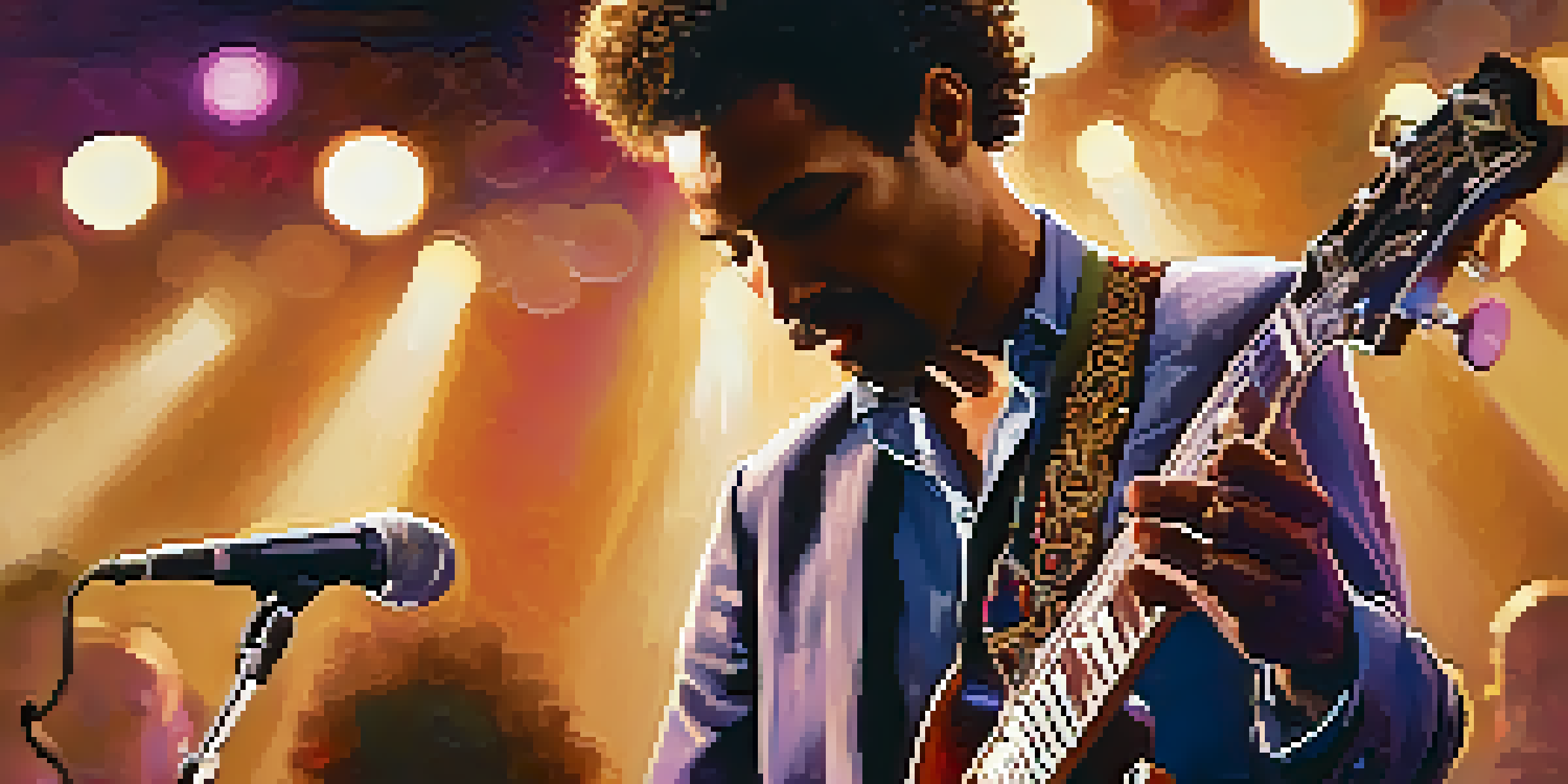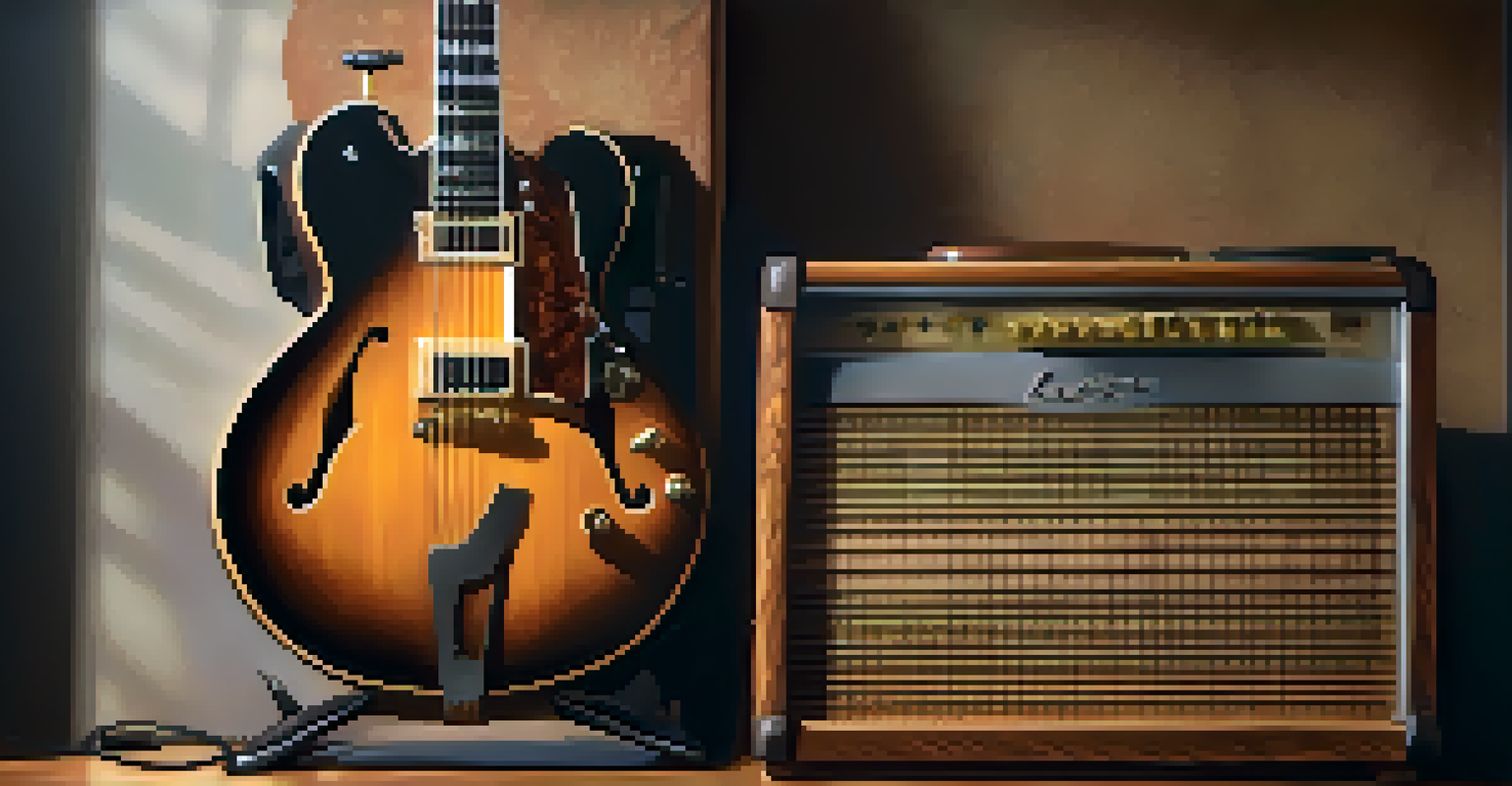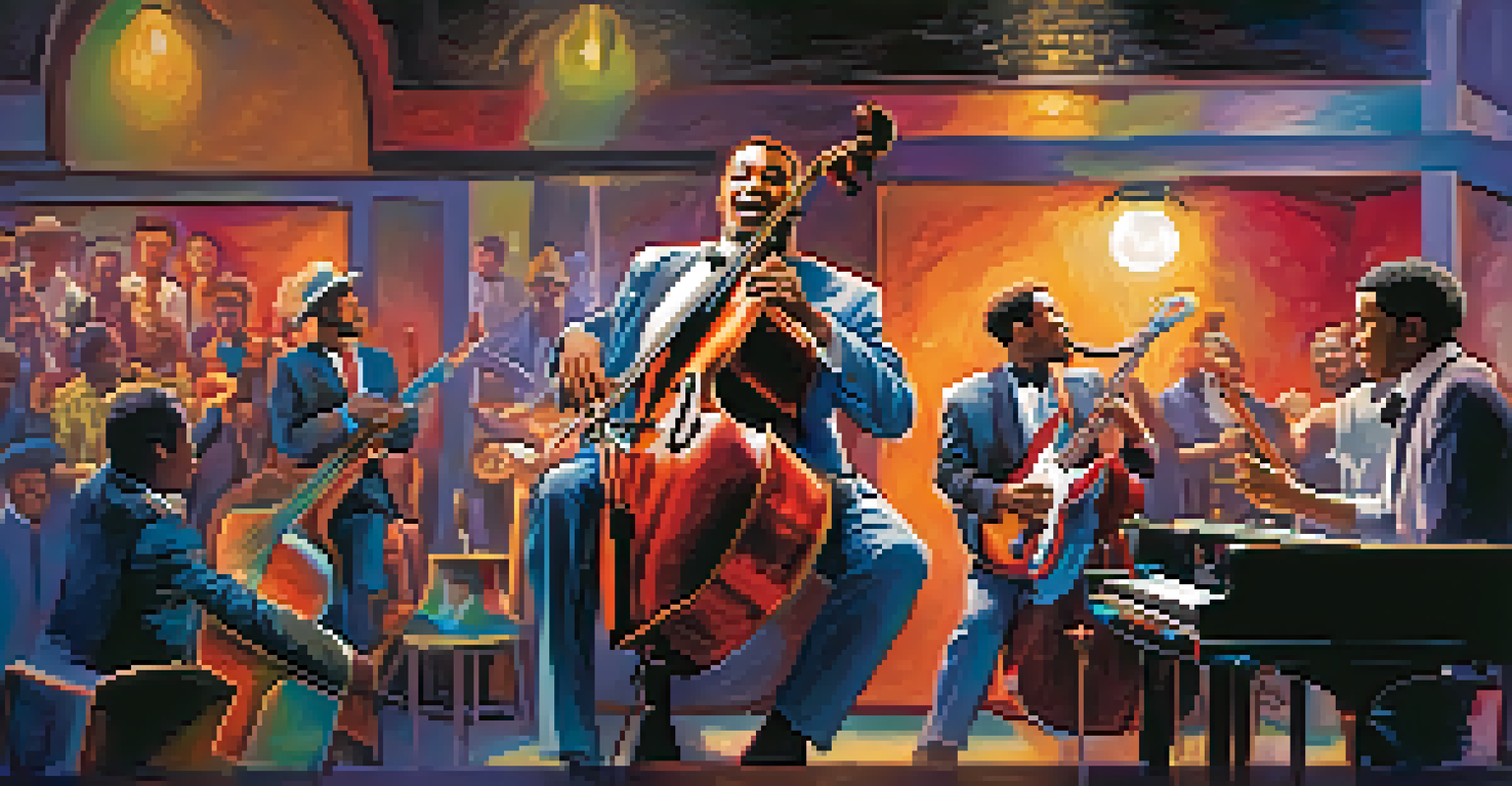Guitar in Jazz: A Cultural Fusion of Sounds and Styles

The Guitar's Role in Jazz History and Evolution
The guitar has carved a unique niche in jazz history, evolving from a simple accompaniment instrument to a leading voice in the genre. Initially, it was often overshadowed by brass and woodwind instruments, but as jazz progressed, the guitar began to shine. Artists like Charlie Christian showcased its potential, blending melodic lines with rhythmic support, which significantly influenced the sound of jazz.
The guitar is a remarkable instrument that resonates with the soul and invites expression in the most profound ways.
As jazz developed through the decades, so did the guitar's role. It transitioned from being primarily strummed to being played as a solo instrument, thanks to innovations in technique and style. The introduction of electric guitars in the 1930s marked a turning point, allowing musicians to explore new sounds and techniques that would further enrich jazz music.
Today, the guitar is an essential element in various jazz subgenres. From bebop to fusion, its versatility allows it to adapt and thrive, making it a favorite among both players and listeners. This transformative journey highlights the guitar's cultural significance and its ongoing contribution to the dynamic world of jazz.
Influences from Blues and Folk Music
The roots of jazz guitar are deeply entwined with blues and folk music, creating a rich tapestry of sound. Blues, with its expressive bending of notes and soulful melodies, has profoundly influenced jazz guitarists. Many jazz players incorporate blues scales and techniques, bringing a heartfelt depth to their solos that resonates with audiences.

Folk music, on the other hand, introduces a storytelling aspect to jazz guitar. The rhythmic strumming and melodic patterns often found in folk songs can be heard in jazz arrangements, creating a familiar yet innovative sound. This blend of cultural influences showcases the guitar's ability to bridge gaps between genres, enriching jazz as a whole.
Guitar's Evolving Role in Jazz
The guitar has transitioned from a supportive role to a leading voice in jazz, showcasing its versatility and cultural significance.
By embracing these styles, jazz guitarists not only pay homage to their musical heritage but also expand the boundaries of jazz. The result is a fusion of sounds that reflects the diverse experiences of musicians, allowing listeners to connect with the music on a deeper level.
Innovative Techniques and Styles in Jazz Guitar
Jazz guitarists are known for their innovative techniques, which contribute to the genre's unique sound. Techniques like fingerpicking, slap bass, and harmonics add layers of complexity and expressiveness to the music. For example, the use of fingerstyle allows guitarists to play both melody and harmony simultaneously, creating a fuller sound that captivates listeners.
Jazz is the only music in which the same note can be played night after night but differently each time.
Another popular technique is the use of complex chord voicings, which can create rich harmonic textures. Guitarists often employ extended chords, like 7ths and 9ths, to add depth to their playing. This complexity is a hallmark of jazz, and the guitar's ability to adapt to these intricate changes showcases its versatility within the genre.
Moreover, improvisation is a cornerstone of jazz, and guitarists have developed their own unique approaches to this art form. They often blend scales and modes, experimenting with phrasing and rhythm to create spontaneous compositions. This freedom of expression is what makes jazz guitar so captivating, allowing each performance to be a one-of-a-kind experience.
Key Jazz Guitarists Who Shaped the Genre
Throughout jazz history, several guitarists have made significant contributions that have shaped the genre. One prominent figure is Wes Montgomery, known for his innovative use of octaves and unique thumb-picking technique. His style became a defining characteristic of jazz guitar, influencing countless musicians who followed in his footsteps.
Another influential guitarist is Jim Hall, who was known for his subtle, conversational playing style. Hall's ability to blend harmonies and rhythms created a mesmerizing listening experience, demonstrating the guitar's potential as a lead instrument in jazz ensembles. His collaborations with other jazz legends further enriched the genre, showcasing the guitar's adaptability.
Blues and Folk Influence
Jazz guitar draws deeply from blues and folk music, enriching its sound and allowing for emotional storytelling.
More recently, players like Pat Metheny and John Scofield have pushed the boundaries of jazz guitar even further. Their incorporation of various musical styles, including rock and world music, has expanded the palette of jazz, making it more accessible to new audiences. These guitarists exemplify how the instrument continues to evolve while remaining an integral part of jazz.
The Influence of World Music on Jazz Guitar Techniques
World music has had a profound impact on jazz guitar, introducing new rhythms, scales, and techniques that enrich the genre. As jazz musicians traveled globally, they encountered diverse musical traditions that inspired them to incorporate these elements into their playing. This cultural exchange has resulted in a vibrant fusion of sounds that defines contemporary jazz.
For instance, the incorporation of Latin rhythms into jazz guitar has created exciting new subgenres, such as Latin jazz. Guitarists like João Gilberto and Antonio Carlos Jobim have seamlessly blended bossa nova with jazz, showcasing the guitar's ability to convey both complexity and simplicity in rhythm. This cross-pollination of styles opens up endless possibilities for exploration and creativity.
Additionally, African and Middle Eastern influences have introduced unique scales and melodic structures to jazz guitar. Musicians often experiment with microtones and polyrhythms, challenging traditional Western concepts of harmony. This blending of musical traditions not only enriches jazz but also fosters a greater appreciation for global music and culture.
Jazz Guitar in Contemporary Music Scenes
In today's music landscape, jazz guitar continues to thrive and evolve, finding its place in various contemporary genres. Many musicians blend jazz with pop, rock, and electronic music, creating innovative sounds that attract a diverse audience. This fusion of styles highlights the guitar's versatility and its ability to adapt to changing musical trends.
Collaborations between jazz guitarists and artists from different genres have become increasingly common. For instance, the partnership between jazz guitarist John Mayer and pop singer-songwriter Ed Sheeran showcases how the guitar can transcend boundaries, bringing together different musical influences to create fresh sounds. These collaborations not only elevate the guitar's status but also introduce jazz to new listeners.
Innovative Techniques Define Style
Techniques like fingerpicking and improvisation contribute to the unique sound of jazz guitar, highlighting its complexity and expressiveness.
Moreover, the rise of digital platforms has allowed emerging jazz guitarists to share their work with a global audience. Social media and streaming services have democratized access to music, enabling talented musicians to showcase their skills and creativity. This shift is helping to cultivate a new generation of jazz guitarists who are redefining the genre in exciting ways.
The Future of Jazz Guitar: Trends and Possibilities
As we look towards the future of jazz guitar, several trends are shaping the direction of the genre. The integration of technology, such as looping pedals and digital effects, is allowing guitarists to experiment with sound in innovative ways. This technological advancement opens up new avenues for creativity and expression, pushing the boundaries of traditional jazz.
Additionally, the blending of jazz with other genres continues to gain momentum. With the rise of genres like jazz-hop and neo-soul, guitarists are finding inspiration in hip-hop and R&B, further diversifying the sound of jazz. This cross-genre collaboration not only attracts new audiences but also enriches the jazz tradition as a whole.

Ultimately, the future of jazz guitar is bright, with countless possibilities for exploration and innovation. As musicians continue to draw from various cultural influences and embrace new technologies, the guitar will undoubtedly remain a vital instrument in the ever-evolving landscape of jazz music.